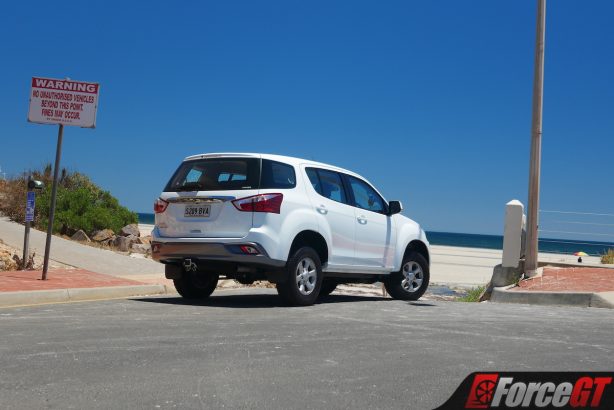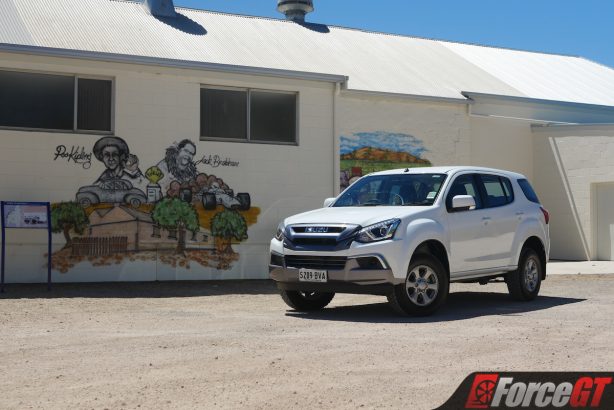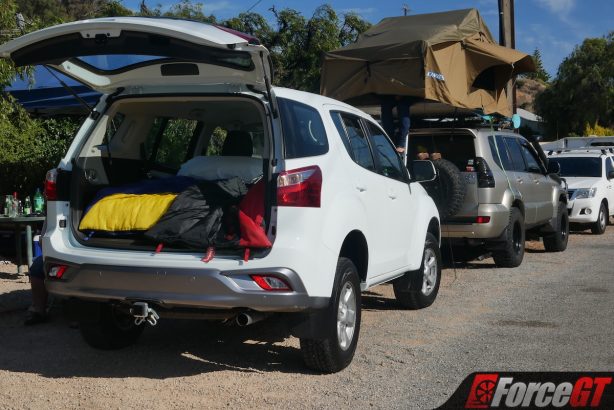It was a month ago when I handed back the keys to the 2019 Isuzu MU-X LS-M 4×4 you see here – slack of me to only get around to writing about it now, I know – and while I like to think that I test cars pretty comprehensively when I have them in my guardianship, I don’t think I’d tested anything quite as comprehensively as I did this.
You see, I had the MU-X at my disposal for a whole fortnight over Christmas and New Years, and while I obviously do a fair amount of driving anyway, the much loved or hated holiday season meant I, like the Leyland Brothers, would be travelling all over the countryside.
It was a good thing then, as I realised by the time I had to give this thing back, that I had something like this and not some flash and impractical little sports car over the holidays, because if there’s one thing that time of year calls for, it’s a road-trip!
Or, at least in my case, two road-trips, but we’ll get to all that later. First though, I ought to do the MU-X LS-M justice by giving you a proper run-down on what it’s all about.
The last time we took a look at the MU-X, it was the range-topping LS-T 4×4 which I decided to take to the Jakem Farm 4×4 park and push it to the limit on some truly harsh terrain. And while the MU-X ate up most of it for breakfast, it did have one issue that arose throughout the day – its low-hanging side-steps kept catching on just about everything.
Knowing my issues from last time, Isuzu UTE Australia’s PR department advised me it would be worth checking out the base-model LS-M you see here as, you guessed it, it doesn’t have any low-hanging and unnecessary side steps on it.
But along with that, the LS-M is the only MU-X variant to come with all-terrain tyres as standard, where the LS-U and LS-T are fitted with road-focused highway-terrain tyres instead – all of which, it should be noted, are variants of the Bridgestone Dueler.
Those all-terrains are fitted to a set of 16-inch wheels on the LS-M, while the top-two come with 18-inch alloys instead, and while the dinky little wheels may not be quite as attractive, they are at least purposeful, as is the rest of the MU-X’s design.
Boxy and basic, it’s a design that, while not especially attractive, lets you know that it means business. With an aggressive facia and that chunky rubber, it’s clearly something aimed at adventurers and hardcore off-roaders. Think of it as more of a tough and functional multi-tool, rather than a hand-crafted wooden-handled pocket knife.
Unfortunately, its basic, rugged nature does carry over to the inside in more ways than one, with this base-model really feeling like one when you look at some of the key items.
The air conditioning controls, for instance, are all manually operated – even the air recirculation vent, although I do love the satisfying thunk it makes when opened and closed – while the seven-inch infotainment system is plainly laughable with low-rent graphics and only the absolute basics ticked off – think radio and Bluetooth, as there’s no sat nav or smartphone mirroring to be found here.
Poke around more and you’ll notice the rear A/C controls and air vents have gone AWOL too, and there’s no digital speedo either. Even the USB ports only charge at a snail’s pace, rather than the faster ones in up-scale variants.
It’s not all bad though, as nearly all of the surprisingly nice interior materials have been carried down the range, with particularly soft leather finishes with contrast stitching on the steering wheel, door cards, armrests, glovebox lid, and above the gauge cluster.
And while there is only cloth seat upholstery, it too sports white contrast stitching, helping the interior feel brought together and surprisingly plush for a vehicle utilitarian in aim. A few other niceties, such as the fantastic LED headlights, are also surprisingly fitted as standard.
Interior comfort is pretty good, with the seats feeling comfortable and supportive in the first two rows and plenty of headroom and leg-room on offer, although the third row is only going to be useful for young children or very occasional use for adults. The only ergonomic complaint would be the lack of reach adjustment on the steering wheel – something that may irk taller drivers.
There’s a good amount of storage space to be found on the inside too, with dual gloveboxes, other enclosed storage compartments on the dashboard and centre console, and even a clever tray underneath the steering column. The only complaint here is that the drink holders are particularly small, so you may want to stick to small coffees.
Under the bonnet of all MU-Xs including the LS-M on test here is the same unstressed 3.0-litre four-cylinder turbo diesel producing 130kW and 430Nm. Paired exclusively to a six-speed automatic transmission in the LS-M, although the LS-U 4×4 one step up is available with a six-speed manual, it’s available with either rear-wheel drive or four-wheel drive, with our test car offering the latter, something that drives up the list price by a shocking $7,210.
Fuel economy is claimed at 8.1L/100km for the 4×4 model on test, and we tested it as using precisely 9.0L/100km after driving mostly on the highway with one passenger and a decent amount, although some round-town and off-road driving was thrown in. Regardless, it’s a very respectable figure for a vehicle with such a large engine and heavy mass.
The four-wheel drive system has selectable 2H, 4H, and 4L modes via a rotary dial on the centre console. Unfortunately, there’s no locking rear differential, but there is at least a very good hill descent control system to assist off-road.

You can read our review of the MU-X LS-T to see just how it performs off-road, as the LS-M performs almost identically. It’s only real difference to, and its greatest assets over the more road-focused LS-T are those smaller 16-inch wheels and all-terrain tyres that can be run at a lower pressure than lower-profile highway-terrains, and its aforementioned lack of side steps that allow for a greater real-world breakover angle.
Off-roading wasn’t the main focus for me this time when I was behind the wheel of the MU-X was how it performed on the open road, as I racked up nearly 1,800km driving it from Adelaide to the Yorke Peninsula twice over the holiday period.
SUVs and 4x4s tend to be my go-to vehicle if I’m going to be driving any sort of distance – although it hasn’t stopped me from road-tripping in plenty of sports cars and hot hatches over the years – and the MU-X is definitely one of the best I’ve come across on the open road.

Despite the chunky all-terrain Bridgestone Dueler tyres, road noise is fairly well suppressed on the open road, as is wind noise despite its slab-sided profile. And although the big diesel donk under the bonnet does sound gruff when you’re on it, it purrs along almost undetectably with the (surprisingly accurate) cruise control set at 110km/h, turning over at around 2,000rpm and savouring its drink.
For as good as its economy is on the cruise, its tank is inescapably small at just 65 litres – easily licked by rivals such as the Toyota Prado and its massive 150 litre tank. You’ll easy go 600km before the fuel light even considers kicking on, which was fine for what I was doing, but if you’re heading further out than I did, you may want to consider bringing a jerry can.
Although it won’t do anything to aid your fuel economy giving it the boot, the lazy diesel does feel surprisingly punchy at higher speeds, with its big turbo and mid-range torque peak making for easy overtaking of trucks and caravans.
The first trip I took the MU-X on was all the way to Moonta Bay on Christmas Day – something that’s been a bit of a family tradition for the past few years – just a few days after I’d collected the keys and spent my initial moments with it tootling around town. Measuring in at a 415km round-trip from my house and a whole-day affair, we loaded up the Isuzu with only the basics – bags of swimming gear, a few snacks for lunch, and plenty of water to cope with the 38-degree heat – and set off.
The first, and really only issue I took with the base-spec LS-M was its lack of satellite navigation. Stepping up one rung to the LS-U add this, and a far nicer eight-inch infotainment system, but in my base model, I simply had to use a windscreen phone mount and Waze to aid my confidence in finding my way to and from.
This trip, ultimately, had little to report back from, as the MU-X made for a great car for the job. Quiet and comfortable, it made the journey a breeze. I must commend it particularly for the padding of its seats, as it never left myself or passengers feeling sore by the end of a long journey.
My second venture in the MU-X, however, was far more eventful. Not originally planning on heading anywhere after Christmas, a group of friends invited me to stay at a beach house one of them had near Ardrossan, at the closer end of the Yorke Peninsula.
Knowing I’d be staying overnight for this deal, the boot of the MU-X was packed full of supplies including sleeping bags and air mattresses. If only someone had told me to bring a tent as there wouldn’t be any room left in the house, because that was exactly the dilemma I faced that night.
Thankfully, however, with the rear rows of seats stowed away, I was able to fit an air mattress in the back with ease and lie down comfortably with plenty of room to lie straight, even at 6’2″. Sure, when my air mattress decided it didn’t want to be full of air anymore at 3:30am it ruined my night’s sleep, but that wasn’t the fault of the car at all. Were it not for that, and it would have been perfect for sleeping in, although a roof tent like you can see on a friend’s car below will obviously make more sense if this is something you’re planning on doing often.
If covering 1,800km, driving in all imaginable conditions, and even sleeping in the back of the MU-X wasn’t a thorough enough test, I don’t know what is, and I think I can confidently say I know it inside and out by this point.
For the driving I had to do these past holidays, I can’t think of many cars that would have handled it better. Its on the open road that the MU-X really does shine, and it could well be the perfect road-trip vehicle, especially when you consider the price.
Although officially listed as costing $50,200 in 4×4 guise, which is awful lot for a base model, a quick look on the configurator on Isuzu’s Australian website reveals a permanent drive-away price of a far more reasonable $44,990 before options. Factor in a five-year warranty with five years complimentary roadside assistance and capped price servicing, and it all adds up to be one very good deal.

Verdict
Design & Comfort
Performance & Handling
Quality
Economy
Equipment & Features
OUR SCORE
3.8/5
+ Plus
- Very comfortable and quiet on the move
- Spacious interior with good-quality materials
- Surprisingly fuel efficient on the cruise
– Minus
- Basic looks
- Low-rent infotainment system without sat nav or smartphone mirroring
- No digital speedo
Overall
While it might not be the prettiest thing in the world, the entry-level MU-X LS-M does make a compelling case for itself thanks to its dependable driveline, tough build quality, smooth and comfortable ride, and sheer off-road ability.
And although it lacks some of the features you’d expect to see in a modern SUV, the price point of around $45k drive-away does allow for some wiggle room to install things like a better head unit or some nicer wheels and even chunkier tyres.
But to answer the initial question of whether this could be the perfect road-trip vehicle, I’d say that it’d probably be my pick again next time of all the 4x4s at this price point. Comfortable and quiet on the move, and surprisingly frugal too, it’s right on the money considering who it’s aimed at and what it’s designed for.
2019 Isuzu MU-X LS-M pricing and specs
| Price (excluding on-road costs): | From: $50,200.00 As tested: $52,274.10 Tested options:
|
| Warranty: | 5 years/130,000km |
| Warranty Customer Assistance: | 5 years roadside |
| Service Intervals: | 12 months/15,000km |
| Country of Origin: | Japan (Built in Thailand) |
| Engine: | 3.0-litre turbocharged common rail direct-injection four-cylinder diesel: 130kW @ 3,600rpm, 430Nm @ 2,000-2,200rpm |
| Transmission: | 6-speed automatic |
| Drivetrain: | Four-wheel drive, dual-range |
| Power-to-Weight Ratio (W/kg): | 62.1 |
| 0-100km/h (seconds): | N/a |
| Combined Fuel Consumption (L/100km): | Claimed: 8.1/Tested: 9.0 |
| RON Rating: | Diesel |
| Fuel Capacity (L): | 65 |
| Body: | 5-door SUV, 7 seats |
| Safety: | 5-star ANCAP, 6 airbags, ABS, EBD, BA, VSC, Hill Descent Control, Hill Start Assist, Trailer Sway Control, rear-view camera, ISOFIX |
| Dimensions (L/W/H/W-B): | 4,825/1,825/1,860/2,845 |
| Boot Space (min/med/max) (L): | 235/878/1,830 |
| Turning Circle Between Kerbs: | 11.6 |
| Ground Clearance: | 220 |
| Wading Depth: | N/a |
| Approach Angle: | 22.2 |
| Departure Angle: | 24.6 |
| Breakover Angle: | 18.7 |
| Kerb Weight (kg): | 2,092 |
| Towing Capacity (kg): | Braked: 3,000/Unbraked: 750 |
| Entertainment: | 7-inch colour touchscreen, AM/FM, Bluetooth, USB, AUX, CD/DVD 8-speaker ‘Sky Sound’ roof-mounted surround sound system |
Competitors: Holden Trailblazer, Toyota Prado, Mitsubishi Pajero Sport, Ford Everest, Haval H9, Toyota Fortuner, Kia Sorento, Hyundai Santa Fe, Toyota Kluger, Mazda CX-9
 ForceGT.com Car News, Car Reviews, Video Reviews, Tuning and much more.
ForceGT.com Car News, Car Reviews, Video Reviews, Tuning and much more. 


































